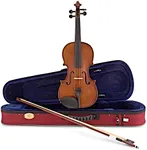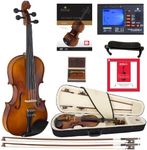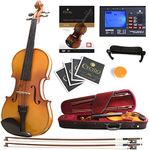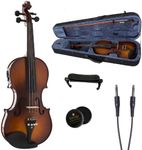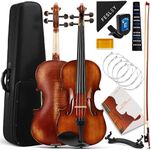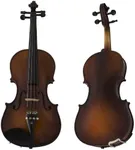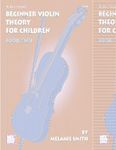Buying Guide for the Best Beginner Violins
Choosing your first violin is an exciting step in your musical journey. As a beginner, it's important to find an instrument that is comfortable to play, produces a pleasant sound, and supports your learning process. While it can be tempting to focus on looks or brand names, the most important thing is to select a violin that matches your size, skill level, and musical goals. Understanding the key features of beginner violins will help you make a confident and informed choice.SizeViolin size refers to the physical dimensions of the instrument, and it is crucial for comfort and playability. Violins come in several sizes, from full size (4/4) to smaller fractions like 3/4, 1/2, and so on. The right size depends on the player's arm length and age. A violin that is too large can be difficult to handle and may cause strain, while one that is too small can hinder proper technique. To pick the right size, measure your arm from neck to wrist and consult a size chart, or try different sizes in person to see which feels most comfortable.
Material and Build QualityThe materials used in a violin, such as the type of wood for the top, back, and sides, affect its sound and durability. Beginner violins are often made from spruce (top) and maple (back and sides), which are traditional choices. Build quality refers to how well the violin is constructed, including the fitting of parts and the finish. A well-made violin will sound better and last longer. When choosing, look for smooth seams, a solid feel, and no visible cracks or gaps. If possible, listen to the sound and check for any buzzing or rattling.
Setup and AccessoriesSetup refers to how the violin is prepared for playing, including the placement of the bridge, strings, and pegs. A good setup makes the violin easier to play and helps it stay in tune. Many beginner violins come as 'outfits' with a bow, case, and sometimes rosin. These accessories are essential for starting out. When choosing, make sure the violin is properly set up or can be adjusted by a professional, and that the included accessories are of decent quality to support your learning.
Sound QualitySound quality is about how the violin actually sounds when played—whether it is bright, warm, clear, or dull. For beginners, a violin that produces a clear and pleasant tone can make practice more enjoyable and rewarding. While you may not need a professional-level sound, avoid instruments that sound muffled or harsh. If possible, listen to the violin being played, either by yourself or someone else, to judge if the sound appeals to you.
PlayabilityPlayability refers to how easy and comfortable the violin is to play, including the feel of the neck, the height of the strings, and the smoothness of the fingerboard. A violin that is hard to press or has rough edges can discourage practice. For beginners, it's important to choose an instrument that feels comfortable in your hands and allows you to play notes without excessive effort. Try holding and playing a few notes to see if the violin feels right for you.



